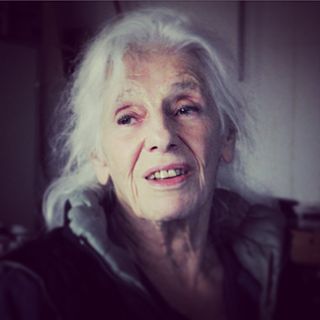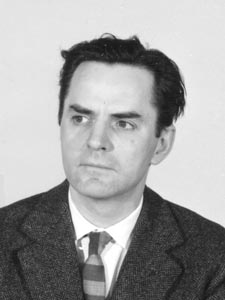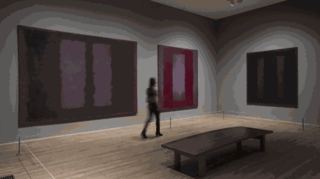
Mark Rothko, born Markus Yakovlevich Rothkowitz, , was an American abstract painter of Latvian Jewish descent. He is best known for his color field paintings that depicted irregular and painterly rectangular regions of color, which he produced from 1949 to 1970.

Clyfford Still was an American painter, and one of the leading figures in the first generation of Abstract Expressionists, who developed a new, powerful approach to painting in the years immediately following World War II. Still has been credited with laying the groundwork for the movement, as his shift from representational to abstract painting occurred between 1938 and 1942, earlier than his colleagues like Jackson Pollock and Mark Rothko, who continued to paint in figurative-surrealist styles well into the 1940s.

Barnett Newman was an American artist. He is seen as one of the major figures in abstract expressionism and one of the foremost of the color field painters. His paintings are existential in tone and content, explicitly composed with the intention of communicating a sense of locality, presence, and contingency.

Color field painting is a style of abstract painting that emerged in New York City during the 1940s and 1950s. It was inspired by European modernism and closely related to abstract expressionism, while many of its notable early proponents were among the pioneering abstract expressionists. Color field is characterized primarily by large fields of flat, solid color spread across or stained into the canvas creating areas of unbroken surface and a flat picture plane. The movement places less emphasis on gesture, brushstrokes and action in favour of an overall consistency of form and process. In color field painting "color is freed from objective context and becomes the subject in itself."
The year 1958 in art involved some significant events and new works.

Carl A. Morris was an American painter. Morris was born in Yorba Linda, California and he studied at the Chicago Art Institute and in Paris and Vienna. He opened the Spokane Art Center through the Federal Art Project during the Great Depression. Morris met his wife, sculptor Hilda Grossman, when he recruited her as a teacher for the center. Moving to Seattle in 1940, they met Mark Tobey and became lifelong friends.

Ilya Bolotowsky was a leading early 20th-century Russian-American painter in abstract styles in New York City. His work, a search for philosophical order through visual expression, embraced cubism and geometric abstraction and was influenced by Dutch painter Piet Mondrian.

Ammi Phillips was a prolific American itinerant portrait painter active from the mid 1810s to the early 1860s in Connecticut, Massachusetts, and New York. His artwork is identified as folk art, primitive art, provincial art, and itinerant art without consensus among scholars, pointing to the enigmatic nature of his work and life. He is attributed to over eight hundred paintings, although only eleven are signed. While his paintings are formulaic in nature, Phillips paintings were under constant construction, evolving as he added or discarded what he found successful, while taking care to add personal details that spoke to the identity of those who hired him. He is most famous for his portraits of children in red, although children only account for ten percent of his entire body of work. The most well known of this series, Girl in Red Dress with Cat and Dog, would be sold for one million dollars, a first for folk art. His paintings hung mostly unidentified, spare for some recognition in the collections like those of Edward Duff Balken, for decades until his oeuvre was reconstructed by Barbara Holdridge and Larry Holdridge, collectors and students of American folk art, with the support of the art historian Mary Black. Ammi Phillip's body of work was expanded upon their discovery that the mysterious paintings of a "Kent Limner" and "Border Limner" were indeed his.

Josephine Gail Baer is an American painter associated with minimalist art. She began exhibiting her work at the Fischbach Gallery, New York, and other venues for contemporary art in the mid-1960s. In the mid-1970s, she turned away from non-objective painting. Since then, Baer has fused images, symbols, words, and phrases in a non-narrative manner, a mode of expression she once termed "radical figuration." She currently lives and works in Amsterdam, Netherlands.

Herbert Ferber was an American Abstract Expressionist, sculptor and painter, and a "driving force of the New York School."

No. 61 is a 1953 painting by the Russian-American Abstract expressionist artist Mark Rothko. The work was first exhibited at the Museum of Modern Art, New York in 1961 but is now in the collection of the Museum of Contemporary Art, Los Angeles. Similar to Rothko's other works from this period, No. 61 consists of large expanses of color delineated by uneven, hazy shades. The Rust and Blue painting was a part of the Color Field Movement as No. 61 relies on subtle tonal values that are often variations of a monochromatic hue. Rust and Blue also uses layered coloring to enrich the hues in the painting, a quality the artist Mark Rothko described as "inner light". Rothko painted in such a way that at times paint can be seen flowing upward across the surface. This illusion can be seen in No. 61 since Rothko inverted the painting toward the final stages of his work.

Red is a play by American writer John Logan about artist Mark Rothko first produced by the Donmar Warehouse, London, on December 8, 2009. The original production was directed by Michael Grandage and performed by Alfred Molina as Rothko and Eddie Redmayne as his fictional assistant Ken.

Sasson Soffer (1925–2009) was an American abstract painter and sculptor. His work has been exhibited extensively throughout the world.

Alfred Russell was an artist who was a member of the early New York school of Abstract Expressionism. He exhibited in Paris and New York along with such well known painters as Willem de Kooning, Jackson Pollock, Ad Reinhardt and Mark Rothko. Later in life, Russell, disillusioned with abstraction, turned to figurative painting, with inspiration from the classical world.

Orange, Red, Yellow is a 1961 Color Field painting by Mark Rothko. On May 8, 2012, it was sold at Christie's from the estate of David Pincus for $86,882,500, a record nominal price for post-war contemporary art at public auction.
The Irascibles or Irascible 18 were the labels given to a group of American abstract artists who put name to an open letter, written in 1950, to the president of the Metropolitan Museum of Art, rejecting the museum's exhibition American Painting Today - 1950 and boycotting the accompanying competition. The subsequent media coverage of the protest and a now iconic group photograph, that appeared in Life magazine, gave them notoriety, popularised the term Abstract Expressionist and established them as the so-called first generation of the putative movement.

The Seagram murals are a series of paintings by Mark Rothko, his first to experiment with a dark palette. Originally commissioned for New York's opulent The Four Seasons Restaurant, he intended for the dark paintings to sicken the restaurant's patrons. After visiting the restaurant where his paintings were to hang, he canceled and returned his first commission. The paintings were stored and later donated some to the Tate. Rothko made 30 in the series in his lifetime.
Finding Rothko is a composition for chamber orchestra by the American composer Adam Schoenberg. The work was commissioned by the Germantown, Tennessee-based IRIS Orchestra under the conductor Michael Stern. It was first performed by the IRIS Orchestra under Stern on January 13, 2007.

Ground Swell is a 1939 painting by American artist Edward Hopper which depicts four people on a heeling catboat in a light swell, looking at an ominous buoy. It was in the collection of the Corcoran Gallery of Art from 1943 until it was purchased by the National Gallery of Art in Washington, D.C. in 2014.
The Ten, also known as The Ten Whitney Dissenters, were a group of New York-based artists active from 1935 to 1940. Expressionist in tendency, the group was founded to gain exposure for its members during the economic difficulty of the Great Depression, and also in response to the popularlity of Regionalism which dominated the gallery space its members sought.
















